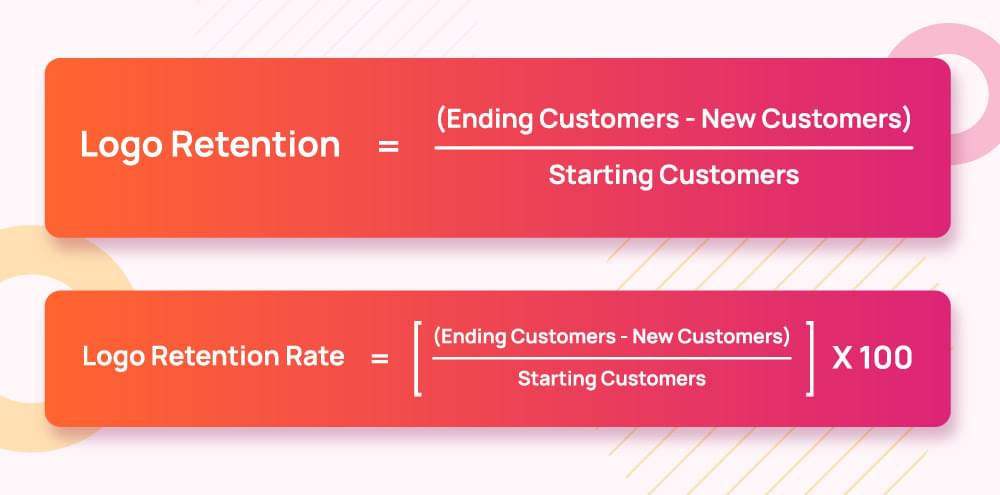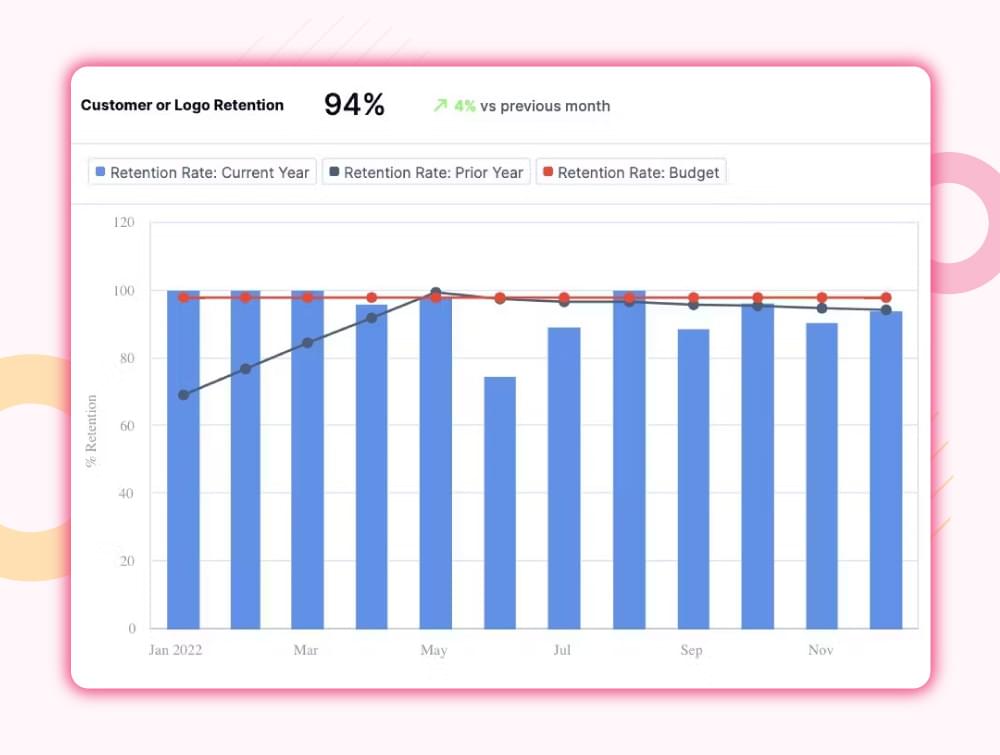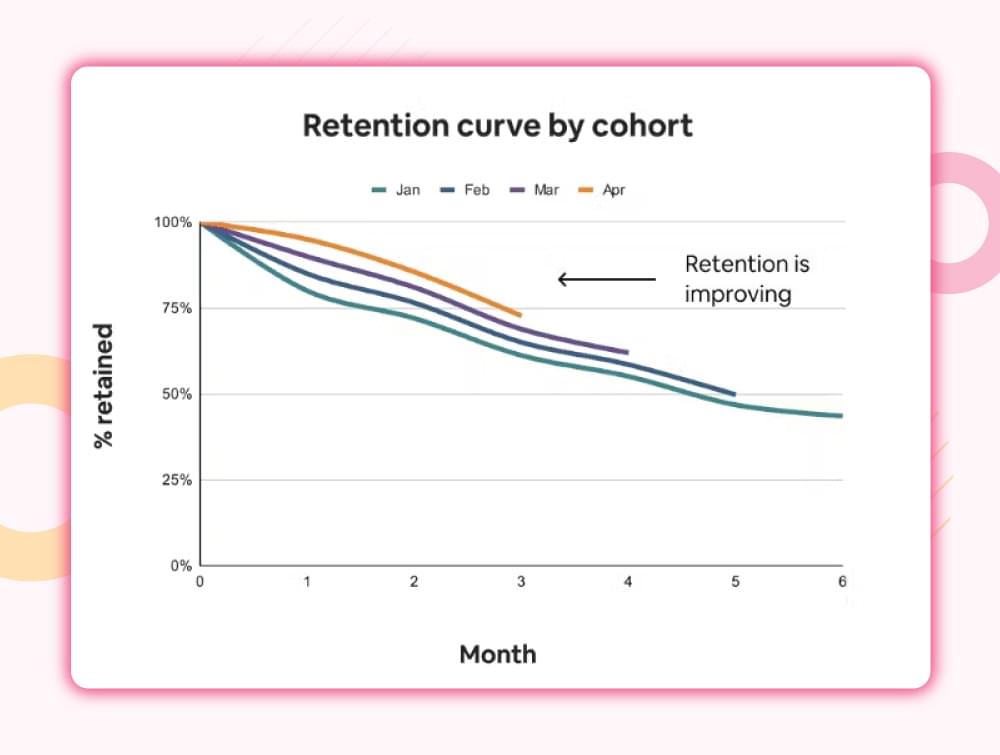
What is Logo Retention? Formula & Why it is Important for SaaS

Let’s talk about something that might sound a little corporate but is actually super relatable: Logo Retention.
Logo Retention is Customer Retention.
If you are running a SaaS (Software as a Service) business or even just curious about how they work, this term is your new best friend. As Eric Ries says, understanding the metrics of your company at the customer level is the key to understanding the effects of your actions. Let’s break it down in plain English if you are into business, especially SaaS.
What is Logo Retention?
Logo retention” refers to the percentage of customers a company retains over a specific period, preferably in the last twelve months (LTM).
Logo Retention Rate is basically your customer loyalty score over the last 12 months. It answers:
“Out of all the companies that were using my software a year ago, how many are still with me today?”
In other words, logo retention is the art (and science) of keeping your existing customers around. The “logo” here refers to the companies or clients you have already signed up. It’s like saying, “How many of these logos (customers) are still sticking with us after a year?” If you lose a customer, their logo disappears from your roster—and that’s called churn. Ouch.
For SaaS businesses, logo retention is like oxygen. Why? Because SaaS companies rely on subscription models of your business. You don’t just sell a product once; you need customers to keep paying month after month, year after year. If they leave, your revenue takes a hit.
However, retaining customers is cheaper than finding new ones.
Studies show it costs 5–10x more to acquire a new customer than to keep an existing one. That means the cost of acquiring a new customer(CAC) is higher than retaining an old user. Imagine spending $100 to get a new client when you could’ve spent $20 to keep a happy one. That’s why logo retention isn’t just a metric—it’s a survival strategy.
The Formula: How to Calculate Logo Retention
To calculate logo retention, you need three numbers:
Customers at the start of a period (e.g., January 1).
Customers at the end of that period (e.g., December 31).
New customers added during that period.
Here’s the formula:
Logo Retention = [(Ending Customers - New Customers) / Starting Customers]
Logo Retention Rate = [(Ending Customers - New Customers) / Starting Customers] x 100

Example:
You start the year with 100 customers.
You end with 110 customers.
You added 25 new customers during the year.
Plug it in the Logo retention formula mentioned above:
1 | Logo Retention Rate = [(Ending Customers - New Customers) / Starting Customers] x 100 |
That means you kept 85% of your existing customers. Not bad! But if your retention rate is below 90%, most SaaS businesses would panic. (More on that later)
Why the Last Twelve Months (LTM) Matter?
When SaaS folks talk about retention, they often focus on the Last Twelve Months (LTM). Why? Because most of the subscriptions renew annually, and a year is a solid time-frame to spot trends. Logo retention therefore, is the same as LTM when referring to customer retention since logo retention calculates the percentage of retained customers in the last twelve months (LTM)s.
Both terms logo retention and LTM refer to the % of active customers between the periods of 12 months. If your retention rate tanks in LTM, you’ve got a leaky bucket. Fix it fast, or you’ll keep losing revenue.
For example, if 10% of your customers left last year, that’s a 90% retention rate. But if that trend continues, you’ll lose half your customers in 5 years. Scary, right? That’s why tracking LTM helps you catch problems early.
Logo Retention Benchmarks and Implications
Let’s say “Startup XYZ” had 200 customers last year but lost 40 of them. Their retention rate is 80%. If they don’t fix leaks, they’ll lose half their customers in ~3 years (math here). Oof.
So, what’s a good logo retention rate?
Logo retention benchmarks aren’t one-size-fits-all—they vary by industry, company size, and business model. In the SaaS world, here’s what is typical:
Enterprise customers: 90–95% retention
Mid-market customers: Around 85% retention
Small business accounts: 70–80% retention
But don’t stress too much about achieving these benchmarks. Instead of obsessing over comparisons, focus on understanding the WHY behind your numbers. What’s driving your retention (or lack thereof)? That’s where the real gold is.
What’s considered “good retention rate” depends on your business. Here’s a quick guide:
If you are targeting enterprise customers, aim for at least 90% logo retention to be best-in-class.
If you are serving SMBs (especially with low entry-price options), aim for 75–80% retention across your entire customer base. For SMB-focused businesses, it’s smart to break down your customer base. Show that your top 25–40% of customers have retention rates above ~80%.
Remember, benchmarks are just a starting point. Your retention rate tells a story—make sure you’re listening to it!
This chart illustrates customer retention over a two-year period. Tracking data across multiple years helps identify trends, measure improvements, and recognize seasonal patterns more effectively.

Why Logo Retention is THE Metric for SaaS?
Let’s get real: SaaS companies live and die by logo retention. Here’s why and how it helps you run your SaaS business more efficiently:
Predictable Revenue and Costs
Subscription models need steady cash flow. If customers stick around, you can forecast revenue and plan budgets. Retained customers mean you are not gambling on new sales every month—you are building a reliable revenue engine. Think of it like a Netflix subscription: if people keep paying month after month, you can plan budgets, invest in new features.
Retained customers generate a steady flow of profits once initial costs are covered. If logo retention drops? You’re stuck in a leaky boat, scrambling to plug holes with costly new customers. For example, if you lose 10% of customers yearly, you’ll lose half your revenue in 5 years.
Related read: Average churn rate for subscription services
Customer Lifetime Value (CLV)
Retained customers aren’t just loyal—they are the profit machines. Retained customers spend more over time, upgrade to pricier plans, and even forgive occasional hiccups. Let’s say your average customer pays $50/month. If they stay for 2 years, that’s $1,200. Lose them in 6 months? That’s $300 down the drain. Loyal customers are less price-sensitive—they will stick around even if competitors undercut you.
Investors love high CLV because it signals long-term health and logo retention boosts CLV.
Related read: What are customer lifetime value and churn rate?
Word-of-Mouth Growth
Logo retention makes happy customers and happy customers refer your business to others. They are your best sale people. Imagine your biggest fan tweets about your software, and 10 new sign ups roll in. Experts call this the “virtuous cycle” of referrals.
Retained customers don’t just stay—they advocate for you. For example, Dropbox grew exponentially by rewarding users who referred friends. Retained customers become your sales team. Learn how you can increase the word-of-mouth Net Promoter Score for your business.
Related read: What is a good NPS score?
Logo Retention is Cheap
Acquiring new customers is expensive. Think about it: ads, sales calls, demos and free trials eat cash. Retaining existing ones? A friendly email or a feature update often does the trick.
Logo retention experts emphasize that focusing on retention frees up resources to improve your product instead of chasing shiny new leads.
Related read: Customer retention management for new and existing customers
Feedback Loop
Long-term customers give better feedback. They have used your product for years and know its quirks. Listen to them, and you’ll build a better product. Logo retention processes involve listening to these complaints, which actually are opportunities to fix issues and turn grumpy users into loyal fans. For instance, Slack famously built its product by obsessively listening to early users.
CRM: Your Secret Weapon for Logo Retention
Customer Relationship Management (CRM) tools aren’t just for sales teams. They’re like a diary that remembers every interaction your customers have with your business. Think of it as your company’s memory bank.
Here’s how CRM helps with logo retention:
SaaS businesses can leverage customer data to improve logo retention.
With the help of this data from CRM tools, your SaaS business can identify at-risk customers and implement logo retention strategies. This way, you can segment your customer base into groups—like high-value clients, at-risk users, or passive customers—and tailor your approach to each.
Think of CRM tools as your business’s ultimate memory bank. They quietly track every interaction your customers have with your company, from support tickets to how often they use specific features. Imagine knowing exactly when a customer hasn’t logged in for a month. Your CRM flags it, nudging you to reach out before they drift away. It’s like having a sixth sense for customer behavior.
But it’s not just about tracking—CRMs help you personalize relationships at scale. Picture sending a birthday discount automatically or celebrating a customer’s one-year anniversary with your product. These small touches make customers feel seen and valued, turning transactions into real connections. And when things go sideways—like a sudden drop in usage or grumbles about pricing—your CRM waves a red flag so you can swoop in and fix the problem before they quit.
How to Improve Logo Retention in SaaS Business?
If you are onto improving productivity of your SaaS business then you must have realized that logo (customer) retention is a key metric. Why? Because it directly impacts the profitability, growth, and long-term sustainability of your SaaS business.
Leveraging data from CRM tools, craft processes to improve every customer touch-point. Some of the suggestions are:
Nail the Onboarding Process:
First impressions matter. If customers don’t understand your product during setup, they’ll bounce. Use tutorials, checklists, or even a quick1:1 call to guide them.
Process of improving logo retention highlights that onboarding is where customers decide if your product is worth their time. Tools like CRM systems can track onboarding progress and flag at-risk users early.
Example: Notion offers interactive templates to help users hit the ground running.
Talk to your Customers and Fix their Problems Fast:
Don’t ghost your customers. Send surveys, ask for feedback, or host a virtual coffee chat to hear their pain points. Logo retention experts found that understanding customer needs is key to retention. Use tools like Churnfree make this easy.
Pro tip: Send a “How’s it going?” email after 30 days. Keep it casual—no corporate jargon.
Complaints aren’t curses—they’re lifelines. If a customer complains, jump on it. A quick resolution can turn a grumpy user into a loyal fan.
Offer them Loyalty Programs:
Reward customers for staying. Offer discounts for annual plans, exclusive features, or early access to updates. Segment customers by their lifetime value to tailor rewards—like a free month for your most loyal users.
Example: Adobe gives loyal Creative Cloud users first dibs on beta features.
Educate Them:
Share bite sized tips, host webinars, or publish case studies. For example, if users drop off after Month 3, send a “Pro Tips for Advanced Users” email series at Month 2. Show them how to get the most out of your software.

Real-World Example: The SaaS That Nailed Logo Retention
A legit example of a SaaS company that significantly improved logo retention through the use of CRM tools and techniques is MBNA Europe.
They heavily invested in screening potential cardholders and implemented targeted marketing strategies.
They did four things:
Rigorous Customer Screening: to identify and acquire customers with high profitability potential.
Targeted Marketing: to align with the specific needs and preferences of its customer segments, enhancing engagement and loyalty.
Personalized Offerings: to meet individual customer requirements, increasing satisfaction and retention.
Proactive Account Management: MBNA maintained regular communication with customers, addressing concerns promptly.
Result? Retention jumped to 97%. This focus on customer relationship management also led to a 75% annual profit growth.
Final Thoughts:
Logo retention isn’t just a number—it’s a philosophy. It’s about treating customers like partners, not transactions. For SaaS businesses, every retained logo means steady revenue, happier teams, and a product that keeps improving.
So, track that retention rate, hug your CRM, and keep your customers close. After all, they’re the reason your business exists.
Let’s keep those logos around! 🚀
Related Read:
Average Customer Acquisition Cost for SaaS
5 Steps to Creating a Customer Centric Strategy for your Subscription-based Business
What is the most direct cause of customer loyalty?
Customer feedback guide, collect and analyze
Customer journey and its stages (free templates)
GRR vs NRR (revenue retention): comparison, track and improve
FAQs
How to Calculate Logo Retention Rate?
To calculate your logo retention rate, use this formula:
Logo Retention Rate = [(Ending Customers - New Customers) / Starting Customers] x 100
Example: If you started the year with 100 customers, ended with 120, and added 25 new customers, your retention rate is:
[(120 - 25) / 100] x 100 = 95%
This means you retained 95% of your original customers.
What is LTM Retention?
LTM (Last Twelve Months) retention measures how many customers you have kept over the past year.
It’s a rolling 12-month window that helps you spot trends. For example, if you retained 90% of customers over the last year, your LTM retention rate is 90%. This metric is crucial for SaaS businesses because it shows how well you are maintaining long-term customer relationships.
What is the Difference Between Logo Retention and Revenue Retention?
Logo Retention: Measures the percentage of customers you’ve kept over a period. It’s about “how many” customers stay.
Revenue Retention: Measures the percentage of revenue you’ve retained, including upsells, cross-sells, and downgrades. It’s about “how much money” you’re keeping.
For example, you might retain 90% of customers (logo retention) but see 110% revenue retention if existing customers upgrade to higher plans.
Is 80% a Good Retention Rate?
It depends on your industry, but for SaaS businesses, 80% is below average. Most SaaS companies aim for 90%+ retention. If your retention rate is 80%, you are losing 20% of customers yearly, which means you’ll lose half your customers in ~3 years. Time to dig into the data and fix those leaks!
What are Other Retention Metrics Besides Logo Retention?
While logo retention is important, you should always evaluate it with other retention metrics like:
- Gross revenue retention (GRR)
- Net revenue retention (NRR)
- Customer lifetime value (LTV)
- Customer acquisition cost (CAC)
- LTV: CAC ratio.


